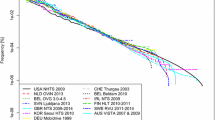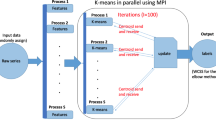Abstract
This study investigates travel behavior determinants based on a multiday travel survey conducted in the region of Ghent, Belgium. Due to the limited data reliability of the data sample and the influence of outliers exerted on classical principal component analysis, robust principal component analysis (ROBPCA) is employed in order to reveal the explanatory variables responsible for most of the variability. Interpretation of the results is eased by utilizing ROSPCA. The application of ROSPCA reveals six distinct principal components where each is determined by a few variables. Among others, our results suggest a key role of variable categories such as journey purpose-related impedance and journey inherent constraints. Surprisingly, the variables associated with journey timing turn out to be less important. Finally, our findings reveal the critical role of outliers in travel behavior analysis. This suggests that a systematic understanding of how outliers contribute to observed mobility behavior patterns, as derived from travel surveys, is needed. In this regard, the proposed methods serve for processing raw data typically used in activity-based modelling.







Similar content being viewed by others
References
Anable, J.: “Complacent Car Addicts” or “Aspiring Environmentalists”? Identifying travel behaviour segments using attitude theory. Transp. Policy 12, 65–78 (2005)
Axhausen, K.W.: Social networks, mobility biographies, and travel: survey challenges. Environ. Plan. B 35, 981–996 (2008)
Brueckner, J.K.: Lectures on Urban Economics. The MIT Press (2011)
Buliung, R.N., Remmel, T.K.: Open source, spatial analysis, and activity-travel behaviour research: capabilities of the aspace package. J. Geogr. Syst. 10, 191–216 (2008)
Chen, D., Lu, C.-T., Kou, Y., Chen, F.: On detecting spatial outliers. GeoInformatica 12, 455–475 (2008)
Croux, C., Ruiz-Gazen, A.: High breakdown estimators for principal components: the projection-pursuit approach revisited. J. Multivar. Anal. 95, 206–226 (2005)
Fanaee-T, H., Gama, J.: Event labeling combining ensemble detectors and background knowledge. Prog. Artif. Intell. 2, 113–127 (2013)
Gim, T.-H.T.: The relationship between land use and automobile travel utility: a multiple indicators multiple causes approach. Transp. Res. Part Transp. Environ. 41, 188–204 (2015)
Hasan, S., Zhan, X., Ukkusuri, S.V.: Understanding urban human activity and mobility patterns using large-scale location-based data from online social media. In: Proceedings of the 2Nd ACM SIGKDD International Workshop on Urban Computing. p. 6:1–6:8. ACM, New York (2013)
Huang, Q., Wong, D.W.S.: Activity patterns, socioeconomic status and urban spatial structure: what can social media data tell us? Int. J. Geogr. Inf. Sci. 30, 1873–1898 (2016)
Hubert, M., Reynkens, T., Schmitt, E., Verdonck, T.: Sparse PCA for high-dimensional data with outliers. Technometrics (2015). doi:10.1080/00401706.2015.1093962
Hubert, M., Rousseeuw, P., Verdonck, T.: Robust PCA for skewed data and its outlier map. Comput. Stat. Data Anal. 53, 2264–2274 (2009)
Hubert, M., Rousseeuw, P.J., Vanden Branden, K.: ROBPCA: a new approach to robust principal component analysis. Technometrics 47, 64–79 (2005)
Hubert, M., Rousseeuw, P.J., Verboven, S.: A fast method for robust principal components with applications to chemometrics. Chemom. Intell. Lab. Syst. 60, 101–111 (2002)
Hubert, M., Vandervieren, E.: An adjusted boxplot for skewed distributions. Comput. Stat. Data Anal. 52, 5186–5201 (2008)
Hunecke, M., Haustein, S., Grischkat, S., Böhler, S.: Psychological, sociodemographic, and infrastructural factors as determinants of ecological impact caused by mobility behavior. J. Environ. Psychol. 27, 277–292 (2007)
Jin, X., Zhang, Y., Li, L., Hu, J.: Robust PCA-based abnormal traffic flow pattern isolation and loop detector fault detection. Tsinghua Sci. Technol. 13, 829–835 (2008)
Jolliffe, I.T., Trendafilov, N.T., Uddin, M.: A modified principal component technique based on the LASSO. J. Comput. Graph. Stat. 12, 531–547 (2003)
Joly, I.: The link between travel time budget and speed: a key relationship for urban space-time dynamics. AET Eur. Transp. Conf. 2004–ETC 2004 4–6 Oct. 2004 Strasbg. 19 p. (2004)
Kandt, J., Rode, P., Hoffmann, C., Graff, A., Smith, D.: Gauging interventions for sustainable travel: a comparative study of travel attitudes in Berlin and London. Transp. Res. Part Policy Pract. 80, 35–48 (2015)
Lichman, M.: UCI machine learning repository. (2013) http://archive.ics.uci.edu/ml
MacFarlane, G.S.: Using big data to model travel behavior: applications to vehicle ownership and willingness-to-pay for transit accessibility. (2014) https://smartech.gatech.edu/handle/1853/51804
Picornell, M., Ruiz, T., Lenormand, M., Ramasco, J.J., Dubernet, T., Frías-Martínez, E.: Exploring the potential of phone call data to characterize the relationship between social network and travel behavior. Transportation 42, 647–668 (2015)
Pitombo, C.S., Gomes, M.M.: Study of Work-Travel Related Behavior Using Principal Component Analysis. Open J. Stat. 4, 889–901 (2014)
R Core Team: R: A language and environment for statistical computing. (2013) http://www.R-project.org/
Rousseeuw, P.J.: Least median of squares regression. J. Am. Stat. Assoc. 79, 871–880 (1984)
Schönfelder, S., Axhausen, K.W.: Activity spaces: measures of social exclusion? Transp. Policy 10, 273–286 (2003)
Singleton, P.A.: Data cleaning in activity and travel surveys: methodology applied to walk trips. Presented at the Transportation Research Board 92nd Annual Meeting (2013)
Sohn, K., Yun, J.: Separation of car-dependent commuters from normal-choice riders in mode-choice analysis. Transportation 36, 423–436 (2009)
Soora, R.: Mobile technologies for activity—Travel data collection and analysis. IGI global, Pennsylvania (2014)
Steg, L.: Car use: lust and must. Instrumental, symbolic and affective motives for car use. Transp. Res. Part Policy Pract. 39, 147–162 (2005)
Stigell, E., Schantz, P.: Methods for determining route distances in active commuting—Their validity and reproducibility. J. Transp. Geogr. 19, 563–574 (2011)
Talvitie, A., Kirshner, D.: Specification, transferability and the effect of data outliers in modeling the choice of mode in urban travel. Transportation 7, 311–331 (1978)
Van, H.T., Fujii, S.: Psychological determinants of behavioral intention to use travel modes in Ho Chi Minh City. Proc. East. Asia Soc. Transp. Stud. 2007, 98 (2007)
Van Acker, V., Goodwin, P., Witlox, F.: Key research themes on travel behavior, lifestyle, and sustainable urban mobility. Int. J. Sustain. Transp. 10, 25–32 (2016)
Van Acker, V., Witlox, F.: Car ownership as a mediating variable in car travel behaviour research using a structural equation modelling approach to identify its dual relationship. J. Transp. Geogr. 18, 65–74 (2010)
Verboven, S., Hubert, M.: LIBRA: a MATLAB library for robust analysis. Chemom. Intell. Lab. Syst. 75, 127–136 (2005)
Viti, F., Tampère, C., Frederix, R., Castaigne, M., Cornelis, E., Walle, F.: Analyzing weekly activity–travel behavior from behavioral survey and traffic data. In: World Conference on Transport Research (2010)
Wedel, M., Kamakura, W.A.: Market segmentation. Springer, Boston (2000)
Witlox, F.: Evaluating the reliability of reported distance data in urban travel behaviour analysis. J. Transp. Geogr. 15, 172–183 (2007)
Wittwer, R.: Cluster-analytical-creation of a typology of young adults’travel behavior in Germany. Procedia Soc. Behav. Sci. 160, 64–73 (2014)
Wu, L., Zhi, Y., Sui, Z., Liu, Y.: Intra-urban human mobility and activity transition: evidence from social media check-in data. PLoS One 9, e97010 (2014)
Zou, H., Hastie, T., Tibshirani, R.: Sparse Principal Component Analysis. J. Comput. Graph. Stat. 15, 265–286 (2006)
Acknowledgments
The Authors would like to thank the Federal Public Planning Service Science Policy (Belspo) and Dr. Eric Cornelis of FUNDP Namur for providing us with the dataset, and Vlaamse Overheid (IWT-SBO project “Urban Logistics and Mobility”-140433) and Vlaams Instituut voor Mobiliteit (project P081 “Transmob”, IWT ref 140203) for providing funding. Mia Hubert and Pieter Segaert acknowledge Grant C16/15/068 of the Internal Fund KU Leuven.
Author information
Authors and Affiliations
Corresponding author
Rights and permissions
About this article
Cite this article
Plevka, V., Segaert, P., Tampère, C.M.J. et al. Analysis of travel activity determinants using robust statistics. Transportation 43, 979–996 (2016). https://doi.org/10.1007/s11116-016-9718-2
Published:
Issue Date:
DOI: https://doi.org/10.1007/s11116-016-9718-2




